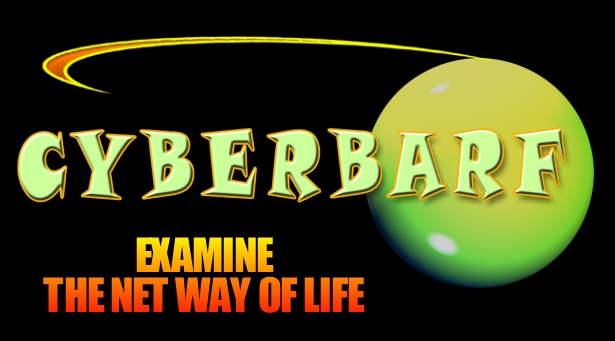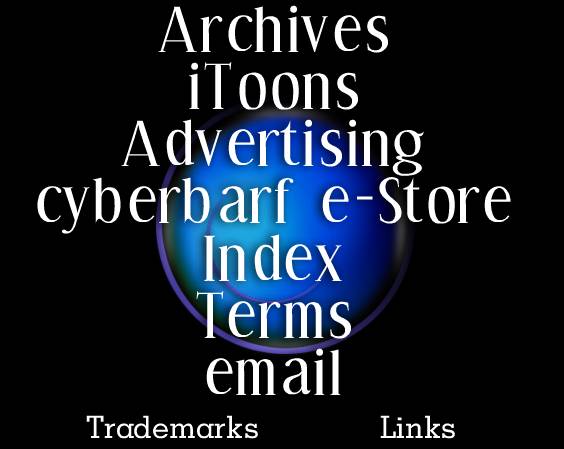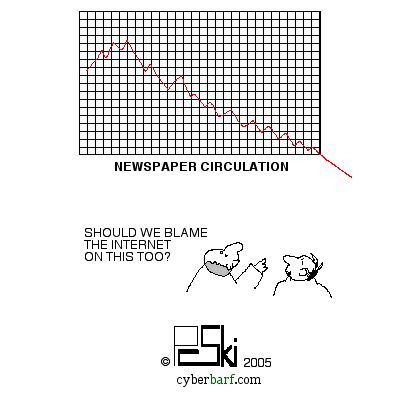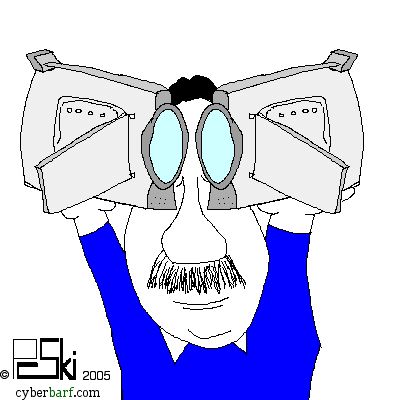cyberbarf
EXAMINE THE NET WAY OF LIFE
Vol. 5 No. 5
December, 2005
|
IN THIS ISSUE: iToon on Newspaper Circulation Teachers & Technology iToon on iFashion The Ken Burns Effect iToon on On Line Poker iToon on nanomas eWorld Revisited iToon on Presidential Play |
|
|
|
Don't forget to check out the CYBERBARF BARF BAG podcast. |
iToon
cyberbarf
EXAMINE THE NET WAY OF LIFE
Teachers & Technology
by Mark R. Rogstad
Educational Correspondent
Two weeks ago, I attended the annual Montana Education Association Conference in the People's Republic of Missoula. Montana public schools take two days off each October to allow teachers to participate in Pupil-Instruction-Related (PIR) activities. The major activity in the state is the MEA conference.
All of the major curriculum areas attend, including technology (TEAM) and computers (MCCE). The best attended sessions are those that deal with federal and state laws. The second best attendance goes to technology/computers.
My "Digital Photo in 50 minutes" sectional packed 55+ teachers into a room smaller than the average living room. (I am thinking of putting a contract out on my colleagues, who refuse to give me a decent sized room.) I've given this same presentation five times in six years with only minor modifications to the PowerPoint show. Yet I pack the house every year. The "What is this Linux?" presentation drew 18 people in the auto shop (another horrible venue). I was stunned that 18 people wanted to know about Linux, a geekified alternative to Windoze.
These teachers hunger for technological knowledge and information. And I am proud to be able to deliver some of it to them.
According to preliminary figures, between 2,000 and 2,500 teachers attended the conference. Compare that to the fact that there are over 16,000 teachers in the state. So about 12-15 percent of teachers attend the conference. The rest, presumably, attend sessions in their home districts. Or they go hunting.
The sad fact is that the majority of public school teachers in Montana, and probably the country, are technologically illiterate, or at least inadequate. There seems to be a sick pride in making statements like "I never use computers." "I hate computers." or "I use a good, old-fashioned paper gradebook." Those statements often are taken with giggles and polite titters, but seldom scorned as they should be.
After some internet-based research, there are no omnibus studies that enumerate the use of technology by public school teachers. Perhaps I have an idea for my dissertation! My belief, though, is that no studies have been published because of the horrendous statistics that would emerge.
There are numerous reasons why teachers don't use technology, or, at least, don't use technology effectively. First among those is the lack of available technology. We tend to see those schools and teachers that excel in technology use and show it off regularly. But what about the small rural schools that don't have high-speed internet connectivity or a budget large enough to equip schools and teachers with the technology and training that they need or want. This applies to a large number of districts in eastern Montana, where it's not unusual for students to commute by bus, two hours each way to school.
Another popular reason is that there is little or no reward or incentive for teachers to change their ways and adopt new technologies. The history teacher that has his lectures on overhead transparencies would have to do a significant amount of extra work to convert them to PowerPoint. But why? Math teachers could toss those endless worksheets and use some of the numerous interactive tutorials available for all areas of math. But that would require them to take significant time to learn the program themselves. Change and Education have often been mutually exclusive terms and still are in many classrooms.
Schools themselves often have large discrepancies between classrooms. I challenge you to visit any school and ask about the most innovative teacher and the most traditional. No doubt you would find classrooms that appear modern and innovative and others that look like they did when you went to school all those years ago. The fact of the matter is that, just like other professions, some teachers enjoy their job and work to innovate while others are teachers so they can get summers off.
The solution? Pressure. Parents should actually go to school on Parent's night and ask their kids' teachers how they use technology in the classroom. Those who give you that cutesy response about not using technology should be told that they should change their attitude about technology. If things don't change, the principal should be notified. If nothing happens, call your favorite school board member.
Contributor Mark R. Rogstad is a college technology teacher. He runs a tech blog, www.techittothelimit.com and communicatingtech.com.
iToon

















